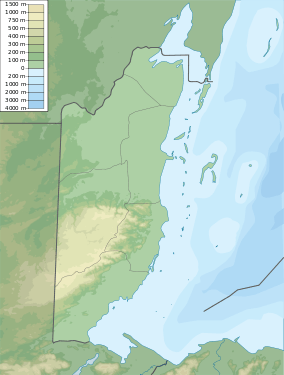Crooked Tree Wildlife Sanctuary
| Crooked Tree Wildlife Sanctuary | |
|---|---|
 Map of Belize | |
| Location | Belize |
| Coordinates | 17°43′26″N 88°32′35″W / 17.724°N 88.543°W[1]Coordinates: 17°43′26″N 88°32′35″W / 17.724°N 88.543°W[2] |
| Designated | 22 April 1998 |
Crooked Tree Wild Life Sanctuary (CTWS) is a protected area in Belize. It is recognized as a Wetland of International Importance. It was designated as a waterfowl habitat on April 22, 1998 under the Ramsar Convention on Wetlands. During Belize’s dry season many resident and migratory birds find refuge in the lagoons. The sanctuary contains16,400 acres of lagoons, creeks, log wood swamps, broad leaf forest and pine savanna, home to hundreds of species of wildlife. The Sanctuary protects globally endangered species including the Central American River Turtle (locally known as Hicatee), Mexican Black Howler Monkey, and Yellow-headed Parrot.[3]
The Jabiru stork is Crooked Tree’s most famous resident. Belize has the largest nesting population of these great birds in all of Central America. Jabiru storks arrive in November to nest in the lowland pine savannas. Two pairs of Jabiru storks are known to nest within the Sanctuary. After the young fledge, in April and May, the birds from the northern and central parts of Belize congregate at Crooked Tree Lagoons. When the rains come, the birds leave to return again the following November.[3]
History
In March of1972, per the request of the Belize Audibon Society and with the approval of the Government of Belize, Dr. Alexander Sprunt IV, Head of the U.S. National Audubon Society Field Office, came to Belize to assess Crooked Tree and make recommendations about its creation as a wading bird reserve. In July he submitted his report and proposal for the establishment of a Natural Area Reserve at Crooked Tree Lagoon. Jabiru stork protection was the Belize Audubon Society’s first advocacy project. In 1973 the Jabiru stork was added to Belize’s list of protected animals. Crooked Tree Wildlife Sanctuary, the first Wildlife Sanctuary declared by the Government of Belize, was gazetted on December 8, 1984.[3]
On August 22, 1998, Crooked Tree Wildlife Sanctuary was declared Belize’s first Ramsar site based on the wetland’s significance, especially as waterfowl habitat.[3]
Location
Crooked Tree Wildlife Sanctuary is just three miles off the Phillip Goldson Highway (Formerly Northern Highway). The junction is located about midway between Belize City and Orange Walk; approximately 30 miles from either direction. Bus services are available (Monday-Saturday) from Belize City to Crooked Tree Village.[3]
Goal
The Main goal of the Crooked Tree Wild Life sanctuary is to protect the area for the thousands of water birds that migrate each and every year.[3]
References
- ↑ "Crooked Tree Wildlife Sanctuary Wetland of International Importance (Ramsar Convention)". protectedplanet.net.
- ↑ "Crooked Tree Wildlife Sanctuary Wetland of International Importance (Ramsar Convention)". protectedplanet.net.
- 1 2 3 4 5 6 "Belize Audubon Society – Crooked Tree Wildlife Sanctuary". www.belizeaudubon.org. Retrieved 2015-09-23.